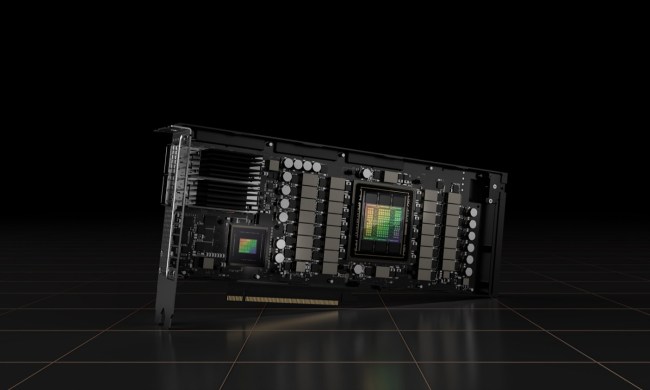

Like many of Nvidia’s products, the company’s new cloud-based EGX Supercomputing Platform relies on the power of graphics processors. Unlike the graphics card inside your gaming PC, however, Nvidia’s new EGX platform lives in the cloud and will help make the world around you smarter thanks to the power of artificial intelligence. Early adopters of the EGX platform include notable businesses like Walmart, BMW, Procter & Gamble, and Samsung, each using Internet of Things sensors, AI processing, and EGX to make their businesses more efficient.
Announcing the EGX platform at Mobile World Congress Americas in Los Angeles, California, CEO Jensen Huang provided several examples of how the company’s partners are AI analytics to improve production. Automaker BMW is using data from videos and sensors on the manufacturing facility to inspect vehicles, while Walmart has set up cameras and IoT sensors in a 50,000 square-foot store that collects 1.6 terabytes of data per second.
The retailer uses Nvidia’s GPU-based EGX platform to send automatic alerts to store associates to retrieve shopping carts, restock shelves, and discard bad meats and produce. “AI is going to bring a higher efficiency to factories to stores and to send us around the world,” Nvidia general manager of enterprise and edge computing Justin Boitano informed Digital Trends in a telephone call ahead of Huang’s keynote.

In another example, the city of San Francisco’s high-end Union Square shopping district has been using EGX to help count the number of pedestrians on the street. The real-time data is sent to local retailers so that they can better engage with customers. More than 100 technology companies worldwide are part of the EGX ecosystem, Nvidia said.
EGX was built to bring the power of AI to the edge so that decisions can be made from large amounts of data in real-time in highly distributed systems. Walmart, for example, would want to deploy the system to 11,000 of its retail stores across 27 countries. To help businesses gain insights into their operations and make sense of all the data that is collected from sensors, Nvidia is also partnering with Microsoft to integrate Microsoft Azure into the EGX platform.
“The NVIDIA Metropolis video analytics application framework, which runs on EGX, has been optimized to work with Microsoft’s Azure IoT Edge, Azure Machine Learning solutions and a new form factor of the Azure Data Box Edge appliance powered by NVIDIA T4 GPUs,” Nvidia stated. “Additionally, NVIDIA-certified off-the-shelf servers — optimized to run Azure IoT Edge and ML services — are now available from more than a dozen leading OEMs, including Dell, Hewlett Packard Enterprise and Lenovo.”
Declaring that the age of intelligent edge computing has arrived, Huang said that the partnership with Microsoft delivers an end-to-end solution from edge to cloud.
Nvidia’s EGX is described as a scalable platform that starts with a Jetson Nano but can scale up to a rack of T4 servers. EGX makes large-scale, hybrid-cloud and edge operations efficient, and IT managers can manage remote GPU-powered servers with solutions from Red Hat.



